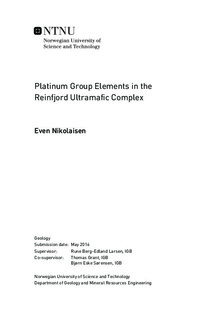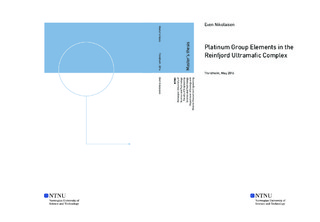| dc.description.abstract | Fifty km W - NW of the Norwegian city of Alta in Troms fylke, is the Reinfjord ultramafic complex (RUC), which is composed of three intrusive events with an age of approximately 560 - 570 Ma (Roberts, 2006). Drill core RF-1 from 2011 show two peaks of economic elements, one Cu-Ni reef low in PGE at a depth of 86-93m and a PGE reef low in Cu-Ni at 107-113m.
The PGE spike in RF-1 is concentrated in a 6m thick section dominated by an orthopyroxene pegmatite and dunite. This section shows a total amount of 0.79 ppm Pt+Pd+Au+Os (Iljina, 2012). The δ34S signature of the PGE reef is -0.40 and the Cu-Ni reef -4.56, a significant difference within 20m (Øen, 2013). This clearly indicates that the sulfur has different sources with low country rock contamination.
This thesis presents a detailed study of the PGE s and their mineral assembly, with the aim of identifying the process(es) that could form this kind of a deposit. Detailed thin section microscopy, BSD imaging, EDS mapping and EPMA identified 61 grains with noble metals in four thin sections. The PGM s are mainly PGE-tellurides situated both in dunite and pegmatite and can be subdivided into three main categories: Pt-dominant (moncheite), Pd-dominant (merenskyite) and Pt-Pd-dominant (mix of the two). These minerals are hosted by base metal sulfides (BMS), indicating that the deposit was generated by magmatic processes.
The PGE reef in the RUC display very different ore forming relation when compared with the massive deposits of Norilsk and Bushveld. The parental melts are thought to derive from a mantle source that intruded into the lower crust at 6-9 kbar, where the RUC represents as an open and active part of a conduit system. The intrusive magmas was either gradually enriched in situ or already enriched in a deeper magma chamber prior to entering the RUC. The reef position in the stratigraphically upper third of the intrusion is very rare for layered intrusions. The magmatic environment does represents the typical models to form a PGE deposit, but strong enrichments of tellurides have only been described at two locations, the Platreef and Merensky reef in Bushveld. A gravimetric model of the reef represents a slightly dipping open bowl, which could suggest that the late arriving, denser PGE enriched melt started to flow/slide parallel to the layering and carved a channel in the underlying cumulates.
Based on all the results presented in this thesis, it is clear that despite a sub-economical grade, the RUC provide a valuable insight in to the ore forming potential for deep seated layered intrusions. | |

